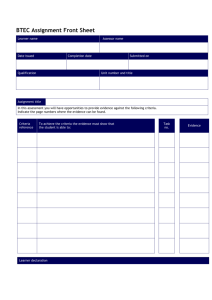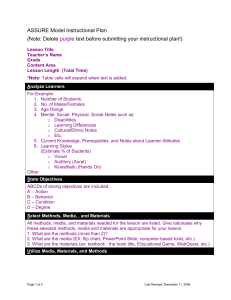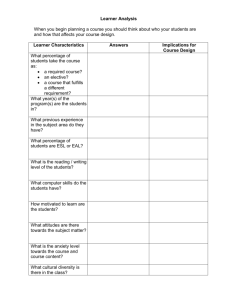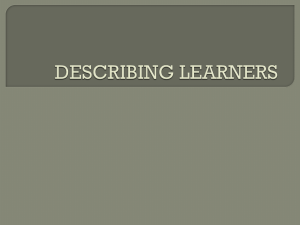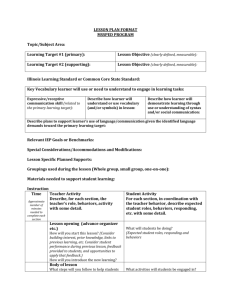Volume 1, Number 3 September 2010 In this Issue:
advertisement
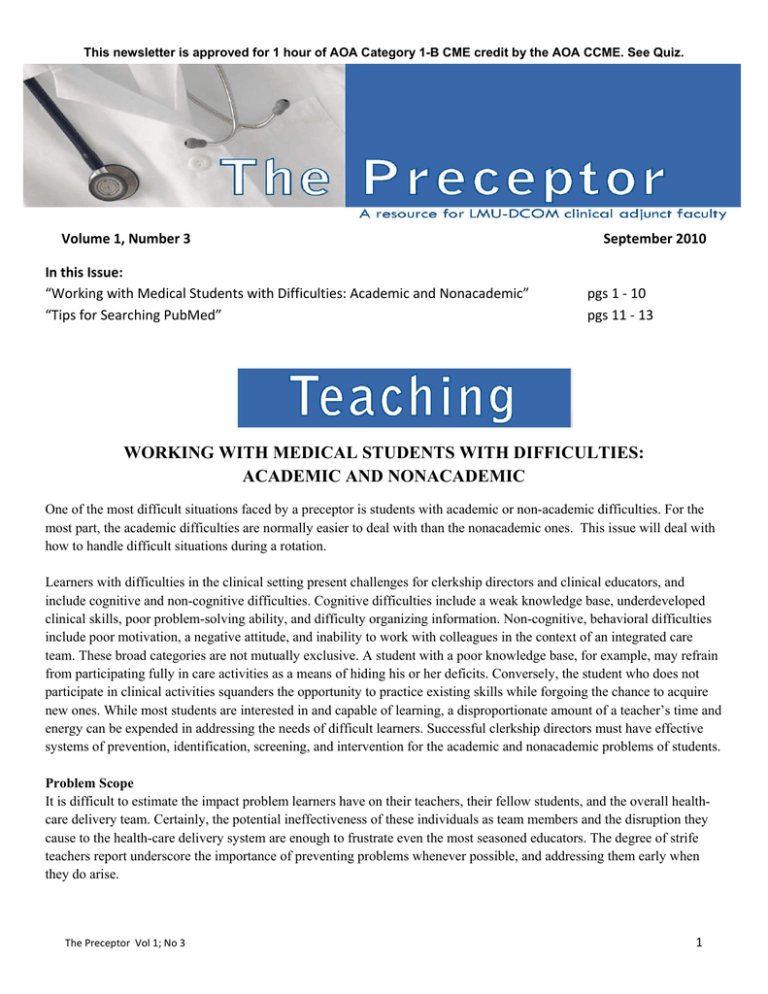
This newsletter is approved for 1 hour of AOA Category 1-B CME credit by the AOA CCME. See Quiz. Volume 1, Number 3 September 2010 In this Issue: “Working with Medical Students with Difficulties: Academic and Nonacademic” “Tips for Searching PubMed” pgs 1 ‐ 10 pgs 11 ‐ 13 WORKING WITH MEDICAL STUDENTS WITH DIFFICULTIES: ACADEMIC AND NONACADEMIC One of the most difficult situations faced by a preceptor is students with academic or non-academic difficulties. For the most part, the academic difficulties are normally easier to deal with than the nonacademic ones. This issue will deal with how to handle difficult situations during a rotation. Learners with difficulties in the clinical setting present challenges for clerkship directors and clinical educators, and include cognitive and non-cognitive difficulties. Cognitive difficulties include a weak knowledge base, underdeveloped clinical skills, poor problem-solving ability, and difficulty organizing information. Non-cognitive, behavioral difficulties include poor motivation, a negative attitude, and inability to work with colleagues in the context of an integrated care team. These broad categories are not mutually exclusive. A student with a poor knowledge base, for example, may refrain from participating fully in care activities as a means of hiding his or her deficits. Conversely, the student who does not participate in clinical activities squanders the opportunity to practice existing skills while forgoing the chance to acquire new ones. While most students are interested in and capable of learning, a disproportionate amount of a teacher’s time and energy can be expended in addressing the needs of difficult learners. Successful clerkship directors must have effective systems of prevention, identification, screening, and intervention for the academic and nonacademic problems of students. Problem Scope It is difficult to estimate the impact problem learners have on their teachers, their fellow students, and the overall healthcare delivery team. Certainly, the potential ineffectiveness of these individuals as team members and the disruption they cause to the health-care delivery system are enough to frustrate even the most seasoned educators. The degree of strife teachers report underscore the importance of preventing problems whenever possible, and addressing them early when they do arise. The Preceptor Vol 1; No 3 1 The impact of learners with difficulties on our training institutions, the health-care system and society is profound. Team communications are affected by disruptive actions, and patient safety and quality of care are directly related to the effectiveness of these communications. Patient dissatisfaction with physicians who have poor physician-patient relationships is associated with a higher malpractice rate. If the offending attitudinal behavior continues unabated, it may be associated with future problems, including subsequent disciplinary action by the state medical board. All participants in medical education share the responsibility to help identify and modify students deficiencies before problems emerge later in their careers. Causes of Learner Difficulties Cognitive Problems Knowledge or skills are often identified more easily than behavioral issues. Knowledge and the ability to retrieve that knowledge are essential for students to develop effective diagnostic reasoning skills. Therefore, learners with an inadequate knowledge base are at a disadvantage. Cognitive deficiencies may be due to learning disability, diagnostic reasoning skill deficiency or inability to integrate knowledge and immature development critical thinking. Further, if the learner cannot think in the abstract, he or she will find it difficult to apply concepts from one clinical scenario to another. Non-cognitive Problems Learners may show a poor attitude, demonstrating disrespect with flippant, arrogant, and other disruptive behaviors. Alternatively, a poor attitude towards learning may be manifested by tardiness, absences, lack of enthusiasm, or commitment, or poor motivation. These problems may originate from a mismatch between the values and expectations of the learner and those of the teacher, from a deficit of professionalism, of from impairment due to mental illness or substance abuse. Behavioral/Professionalism Professionalism deficiencies result from behaviors that compromise honesty, integrity, responsibility, and communication. Many teachers (faculty and residents) are uncomfortable or reluctant to assess honesty, integrity, maturity, and responsiveness to criticism. However, teachers should be responsible for assessing the professional behaviors as well as knowledge and clinical skills of the learner. Their responsibility includes teaching, assessment, feedback, and directed remediation regarding cognitive and professional issues. Faculty development to help teachers gain confidence and skills to assess professionalism is a critical function of clerkship directors. Substance Abuse Impaired performance associate with substance abuse can be particularly difficult to identify because it may masquerade as behavioral problems. Chemical dependency, the leading cause of physician impairment, has a lifetime prevalence of 10% to 15%. Medical students and residents experience alcoholism at a rate similar to that of the general population and gender differences are small. Some studies have shown that medical students and residents may have a lower rate of nonalcoholic substance abuse compared to the general population, but other studies report a higher rate, comparable to that of practicing physicians, whose abuse of opiates and benzodiazepines is facilitated by self-prescribing. Learner’s behaviors consistent with impairment due to substance abuse are not precise, and therefore, recognition may be difficult. In addition, diagnosis of substance abuse carries significant social and professional ramifications. For this reason, physician-teachers are often hesitant to identify behavior as an indication of potential substance abuse despite their understanding of the serious consequences for patient safety. Factors that may predict physician alcohol-related problems include a family history of alcoholism, narcissistic personality style, a perception of low parental warmth in childhood, and stressors in the learner environment. Since stress is an integral part of the training process, maintaining abstinence requires ongoing treatment and monitoring. The Preceptor Vol 1; No 3 2 Mental Illness Mental illness may cause physician impairment that threatens patient safety, but at a much lower rate than substance abuse. Depression, anxiety, and other psychiatric disorders that are not adequately controlled often manifest during learner’s clinical experiences when multiple stressors are applied in novel situations. Recognition and modification of stressors before the learner experiences problems require vigilance. Anxiety, depression, or other psychiatric disorders can predispose an individual to alcohol abuse. Therefore, initial evaluation of suspected substance problems should include screening for anxiety. Screening and Identification Clinician-educators, including clerkship directors, are often uncomfortable identifying and providing feedback to students who exhibit difficulty. The teaching clinician may be inclined to focus on cognitive performance and accept knowledge gaps and difficulties with integration and synthesis as appropriate for the learner’s level of education. Learners with underlying behavioral difficulties often are not noticed or the “warning signs’ are overlooked, and therefore, the difficulty remains unidentified. The problem is compounded further when educators assume that medical students, as adult learners, are self-reflective, diagnosing the source of a particular behavior problems. Even when students are self-reflective, diagnosing the source of a particular behavior can be problematic. It is particularly difficult to identify problems with motivation, level of interest, or knowledge when a student is shy or non-assertive. Separating the learner’s innate character (e.g. shyness) from nonproductive behaviors (e.g. lack of motivation) is challenging. As a result, the learner may be perceived to be the problem, rather than his or her behaviors. Feedback and interventions should focus on learner actions, which are changeable, rather than on the individual’s personality characteristics, which are not. The teacher may prefer to avoid addressing behavioral problems. However, allowing the non-productive behavior(s) to continue unchecked compromises the educational experience of the individual student and his or her teammates, and potentially, the care of the patients. The learner’s peer group may be more astute at identifying problem behaviors than the teachers. Peer-learners readily identify problems related to teamwork and work ethic. However, like teachers, they are often reluctant to address the problem. Identification of problems by peers and others in a 360-degree evaluation can be an effective tool in identifying this type of learner difficulty. The individual learner may not be aware of his or her behavior or its effects on others. Alternatively, the student may become stressed by his or her own difficulties. Even if distressed, he or she may be unable to pinpoint specific causes and may readily place blame on others. Guidance is therefore an integral part of the internal reflection and behavior modification process. Teachers are often inexperienced in identifying problem behaviors. Their contacts with learners may be episodic, superficial, and lack of depth required to identity problems. Further, they may be concerned about seeming judgmental towards a student. Clerkship directors must support and reinforce the important role of teachers in identifying problem behaviors. Remember, the leaner is not the problem; the problem is the unprofessional actions or unacceptable behaviors. Part of the problem in identifying students with difficulties resides in the teacher. Faculty are often unwilling to record negative comments about students because of inadequate guidelines for handling problem students, uncertainty about whether the problem is “real” (which may result from a lack of sharing information before the start of the rotation), or fear of repercussions. Teachers may overlook problems and pass the student and problem to the next rotation, thereby avoiding the inconvenience and awkwardness of a confrontation. However, in the long run, ignoring the issue does not help the student and reflects abrogation of responsibility. The Preceptor Vol 1; No 3 3 Standard Clerkship Evaluations That Document Behaviors Help Identify Problems Clerkship Director and Preceptor Assessment Narrative summaries are often based on faculty and resident comments concerning student performance. Most programs use mid-clerkship formative evaluations to give students feedback and end-of rotation summative evaluations to determine grades and provide additional feedback. At a minimum, these evaluations should cover knowledge base, clinical skills, and communication-interpersonal skills. Assessment of professional attributes based on observation of behaviors is an important dimension of evaluation. Evaluators should be encouraged to document problematic student behaviors and, with the assistance of the clerkship director, determine how best to address problems and document issues. Self-Assessment Self-assessment during medical school is valuable for assessing non-cognitive skills and prompting continuous professional development. First year medical students self evaluations tend to be more critical of their performance than those of the faculty. Helping students develop self-assessment skills promotes reflection on and improvement in behavioral attributes. Self-assessment also illustrates whether students have insight into their problem behaviors. Peer Assessment Peer evaluation of medical students can be helpful in giving feedback on trends and perceptions of performance. Medical students are astute at identifying peers who do not display acceptable behaviors. However, in one study they exhibited less skill in judging their peer’s cognitive ability. The 360 degree evaluation process is a useful tool to provide learners with insight into how others perceive their actions. Objective Assessments Oral, essay, or multiple choice examinations may assess learner knowledge about process and content of professionalism, but are not useful for assessing actual behaviors. Objective structured clinical examinations (OSCE), ratings or audio or videotape, and directed/scored observations with real patients may be used to assess competency. Screening to Identify Impairment Substance use is not uncommon among medical students. The stress of medical education and high performance expectations may be associated with substance use or abuse. However, whether to screen medical students is controversial. Many schools have a “wait to act” attitude and, therefore, impairment or abuse usually comes to the attention of the administrators after an “event.” Faculty hopes that a “wait to act” attitude fosters students trust, professionalism, and a sense of responsibility. Many schools, however, are adopting more aggressive approaches. However, non-random testing may not result in any more advance notice than waiting for some evidence of impairment. Screening for a criminal record or drug or alcohol use is an institutional, not a clerkship-specific issue. Nonetheless, clerkship directors and faculty should be aware of the policies and trends. Routine Screening for Drugs and Alcohol Routine urine drug and alcohol screening is controversial. Many hospitals require urine drug screens on new medical staff and have a policy of “screening for cause.” Traditionally, screening programs are costly and their effectiveness in preventing or identifying users is unclear. The effectiveness of urine screens in medical education has not been defined. Hopefully, more students who have substance problems will be identified before and “event” occurs as a result of increased emphasis on symptoms indicative of substance problems and profession responsibility to identify colleagues with problems. Students should be educated about identifying, assessing, and managing substance abuse. They should also be engaged in discussions about professional and personal responsibilities relevant to substance use and abuse. Once identified, treatment and intervention strategies must be implemented discretely. Clear expectations and goals from treatment need to be expressed. If a student fails to progress, then follow through with next-step intervention is required. The Preceptor Vol 1; No 3 4 Assessment for Learning Disabilities Some students with learning disabilities are identified before they enter medical school. Others will be identified in medical school when previously successful learning strategies decompensate because of the stress caused by a greater work load. Diagnosis and documentation should be comprehensive and performed by a qualified evaluator. The school’s administration should consider how recently the assessment was conducted, the appropriateness of documentation, and evidence to support the need for each recommended accommodation. The evaluator should provide evidence to demonstrate that the student has a significant limitation to learning. Ultimately, each medical school must have its own policy regarding diagnostic testing and documentation. Neuropsychological tests with adult normative data are available, but no single battery of tests can identify all learning disorders and there is no clear consensus about which test should be used. Prevention of Problems Primary Prevention Primary prevention of student problems can begin with the selection and admission process and should continue throughout the medical school experience. Curriculum Design A well-designed and progressive curriculum allows learners to grow in stages and is built on prerequisite material. Design of the curriculum should ensure that no one step is too large or that it skips steps in developing fundamental reasoning skills. Vigilance Vigilance and targeted feedback are critically important in the early stages of the learner’s progress. If a learner has academic difficulty, a formal mechanism to help that student and follow his or her progress in the future may prevent further difficulties. Clerkship/rotation Design Strategies to prevent difficult learner-teacher situations begin with clear communication of expectation for learning and performance. Objectives that clearly state expectations for performance should be shared with all students and evaluators. Orientation of learners is critical and should include formation such as arrival time, dress code, and format of documentation and presentation in the clinical setting. The clerkship director should strive to create an atmosphere where learners feel comfortable reporting any type of difficulty and feel assured of a non-punitive response. Learners’ expectations should be discussed openly and if they cannot be met, the learner should understand the rational and the options that are available. Formal, mid-rotation feedback allows learners and teachers to identify and rectify problems. If the learner is having any difficulties, interim feedback can be helpful in creating a path for improved performance. Feedback should be provided to both learners and teachers. Testing provides measurement of competency and achievement of specified learning objectives and can be used for formative or summative purposes. Systems Support Most institutions have programs that provide support for stress reduction, financial assistance, supervision and risk control, and assistance with effective communication. These programs should be used effectively and their availability reviewed with faculty, residents, and learners. The Preceptor Vol 1; No 3 5 Secondary Prevention Secondary prevention refers to early identification of incipient problems before the learner displays significant problematic behavior. Clerkship directors should encourage preceptors to notify them of students with potential problems as soon as they are identified. Poor mid-rotation formative evaluation indicating behavior problems, such as lack of professionalism or repeated errors, may identify a student who is having difficulty in time for the students to receive feedback and improve performance before the end of the rotation. Early hints of problematic behavior are often communicated vaguely by a concerned staff member, a disgruntled patient or family member, or as a result of a problematic interaction with a fellow learner. Intervention After Problems Emerge A General Approach: SOAP Langlois and Thach recommend intervention based on a “SOAP” framework, using the following steps:1 Subjective: Use your experience and opinion to gain an individualized impression of the student’s difficulty Objective: Document specific examples of the problem Assessment: Diagnose the problem Plan: Develop and implement a plan to address the problem This approach encourages specific, constructive feedback to the learner as well as a plan for correction of problem or remediation, including review with the student. Education leaders at your institution may be helpful with this process. You should have a low threshold for seeking assistance and advice. These are difficult situations to handle, even for experienced clerkship directors. Intervention for Behavioral/Professional Issues Design an approach to remediate deficiencies in professionalism must be focused on changing student behaviors, not on changing underlying attitudes or motivating factors. Changing behavior requires adaptation and assessment of readiness to change. Prochaska and DiClememte’s2 model of behavior change, originally designed for changing patient behavior, can be useful in changing leaner behavior also. Their model consists of three stages of change, pre-contemplative, contemplative and determination. Pre-Contemplative Stage In the pre-contemplative stage, the learner’s self-awareness and reflection are minimal. The learner does not realize he or she has a problem, and does not understand the need for change. The learner often has no insight into how he or she is perceived. The student must be made aware of the problem by frank, objective examples of the offending actions. It may be helpful to help the learner walk through the possible outcomes and consequences of his/her unacceptable actions. Multiple examples from various environments are helpful in making the student understand the problem. The most common defensive mechanism student’s use is to blame others or the system for the events/actions. When the learner becomes aware that he or she has a problem behavior, the process can move to the contemplative stage. Contemplative Stage At this stage, the learner is aware that a problem exists and recognizes the need to change. The student knows something is wrong, can describe the settings in which the problem arises, and realizes his/her response is not optimal. However, he/she may not have enough insight and experience to develop strategies to correct the problematic behavior. 1 2 Langlois JP, Thach S. Preventing the difficult learning situation. Family Medicine 2000;32:232‐34. Littell JH, Girvin H. Stages of Change. A critique. Behavior Modification. 2002; 26‐223‐73. The Preceptor Vol 1; No 3 6 Determination Stage The determination stage occurs when the learner both recognizes the problem is larger than a single example (i.e., he or she sees the problem abstractly) and knows that change is needed. Once this stage is reached, the learner can develop strategies to correct the problem. Behavioral change requires ongoing involvement of a faculty mentor and learner. A daily log and behavioral contract may be helpful tools in facilitating behavior change. The daily log should include a list of specific desirable actions or responses in checklist format and the behavioral contract should establish boundaries and limits regarding tolerance of breaches in the agreement. Continuity of the faculty mentor is helpful to establish trust and consistency. Decisions about sharing performance difficulties with up-coming faculty must be made on an individual basis and the learner involved when additional faculty are included in other wise confidential guidance. Such information could be helpful in allowing faculty to help the student or could bias the view of such learners. You should discuss your schools policies and seek guidance with the appropriate person in the dean’s office. The student may experience relapses and disappointments, but the mentor’s approach should remain consistent and encouraging. The learner will understand and better adhere to the plan if the learner and mentor acknowledge the difficulty of changing behavior and underscore the need for that change. Documentation with the learner’s signature on frequent evaluations is mandatory to minimize liability and maximize the remediation process with difficult behaviors. Intervention for the Learner with Impairment Physicians are more likely than the general population to respond to alcohol and drug addiction programs. Their success with abstinence may be related to the direct consequences of failure to comply with their treatment plan, including loss of hospital privileges and state licensure review. Intervention is most likely to succeed if it consists of a combined approach of confrontation and concern. When behavior consistent with impairment is present, the institutional policy usually requires a review by a specialist. An institution-level committee usually refers the student for evaluation. Members of the committee are usually either directly aware of a student’s addiction or are addressing behavior concerns that may be related to addiction. Meticulous documentation, involvement of faculty, and strict adherence to due process are critical for the success of referrals and intervention programs. Students diagnosed with addiction who undergo appropriate treatment may be required to be monitored throughout the remainder of medical school and beyond. Intervention for the Learner with Academic Failure Exploration of a problem should begin as soon as potential problem is suspected. The clerkship director should talk to the student and explore the student’s perception of the problem, the student’s strengths and weaknesses, and current life stressors. A history of past academic performance should also be ascertained. One should try to assess if current problems are due to teacher-student incompatibles or problems arising due to the learning milieu. Steinhert and Levitt3 generated a useful algorithm for working with the “problem” resident, which applies to working with students with problems. They outlined specific questions to ask when designing an effective remedial intervention. What is the precise pattern to be addressed? Does it involve knowledge, skills, or attitudes? What Methods will be used to address the problem? Some of the methods that may be useful to help learners with knowledge problems may include: Personal one-to-one assessment of knowledge and skills deficits by attendings or resident teachers Clinical case discussions 3 Steinhert Y, Levitt C. Working with the “problem” resident: Guidelines for definition and Intervention. Family Medicine. 1993;25:627‐32. The Preceptor Vol 1; No 3 7 Assignment of additional reading to provide a clearer knowledge foundation, with subsequent discussions of the reading Assigned exercises such as time in clinical skills labs, extra patient assignments, etc. Recommendations about time management or organizational skills Referrals to other sources of help if it appears that the student has personal problems that interfere with efforts to study or evidence of learning disabilities Involve the student in the design and assessment of the intervention Who will be involved in the intervention? The clerkship director, residents, and attendings on the team may be involved. However, educators beyond a single clerkship may be needed. What is the time frame for intervention? Determine reasonable expectations for the duration of a successful intervention. It may be longer than the duration of a clerkship. How will the relevant issues be documented? It is essential that the clerkship director document the nature of the problem, discussions about the problem, and the intervention plan. How will the intervention be evaluated? The evaluation mechanism for assessing improvement must be defined before the intervention is implemented. Sessions for feedback and evaluation between the student and teacher must occur regularly to monitor progress in meeting the goals of the intervention. Who should know about students with problems? Some problems can be handled during a single clerkship or rotation, but most problems that come to the attention of a clerkship director are manifestations of an ongoing problem. One mechanism of dealing with students with problems is to convey information to other teachers so that an individualized teaching strategy and optimal learning condition may be planned for the student on subsequent rotations. One potential risk of sharing information is potential bias against the student during subsequent interactions and assessments. However, the benefits of shared knowledge exceed the detriments. Most medical schools have mechanisms and policies regarding when, how, and with whom to share information about students with problems. In various circumstances, information may be shared with faculty, course directors, student advisors, clerkship directors, student review subcommittees, and the office of the appropriate education dean to facilitate ongoing educational interventions. Students should be aware of the process of sharing such information and should be notified of what data will be shared and with whom. Intervention for Academic Failure due to Learning Disabilities Once a learning disability is diagnosed and documented, interventions include remedial plans and appropriate academic accommodations. Medical Schools must be prepared to assist students with learning disabilities by developing policies and procedures, assembling a team of resource people, and educating administrators, staff, and faculty about LD. Faculty must understand that learning disabilities are not related to intelligence, but rather represent areas of relative weakness in information processing. Students with LD often have areas of great cognitive strength and high motivation to learn. Diagnosis of a specific LD generally allows affected students to regain confidence as learners, to develop rational compensatory learning strategies, and hard work with educators to develop alternative or supplemental learning approaches. The Preceptor Vol 1; No 3 8 Examination accommodations are the most frequent adjustments made for LD medical students, including extra time (generally time and a half, but sometimes double time), a separate examination room to limit distractions, a reader or scribe for tests, a computer for essay examinations, and a flexible examination format. Other accommodations include extended time to complete assignments, courses, or the full degree program, academic counseling, tutoring, providing note-takers, video or audio recordings of lectures, and computer-assisted learning or other multi-modality approaches to instruction. Legal Concerns Negative Assessments and Dismissal Medical school faculty and other evaluators often are reluctant to give negative feedback in medical student evaluations because they fear becoming involved in a lengthy review process. Academic review committees may temper their findings and pass marginal or even unsatisfactory students due to the threat of being sued for failure to provide fair treatment and due process. However, adverse academic actions are held to a different standard that civil disciplinary actions. Courts generally uphold academic actions that are well documented and in the interests of the institution and society as long as they are not arbitrary and capricious, and the institution followed its own due process. Students who are performing unsatisfactorily should receive feedback, including recommendations for improvement. Documenting meetings, interventions, and outcomes is essential. Documentation about student deficiencies and interventions should be similar to documentation in a patient’s chart. Documenting that the student was made aware of deficiencies is important. Consequences of failure to progress need to be clear to the student and within the realm of the evaluator. For example, a clerkship director may fail a student in the clerkship or refer him or her to the dean’s office, but may not dismiss the student from medical school unless dismissal is within the clerkship’s power. Even though you may be very clear on what transpired between you and the student, it is important that it is documented in a way that others who may view this information get a clear picture of how the issues were handled. Fair and Equitable Treatment Generally, courts will not intervene in faculty decisions regarding academic cases as long as the faculty members used professional judgment, reviewed the entire record of performance, and gave the student due process. There must be no evidence of arbitrary and capricious actions on the faculty or institution. Due Process Each institution must have a detailed due process policy that outlines the student’s hearing and appeals rights, and the steps that must be taken by both the student and institution when an adverse action is initiated. Adequate documentation of adherence to the policy is helpful in upholding institutional decisions that adversely affect a student. ADA and Medical Students The ADA ensures protection to individuals with disabilities in areas of service relevant to colleges and universities, including admission and recruitment, student programs, academics, nonacademic services, and health services for public and private institutions. Major issues related to adherence to the ADA for medical students include admission policies regarding qualified individuals with a disability (beyond the range of this monograph), assessment, reasonable accommodations for the program, and academic progress examinations. Within the setting of a clerkship (rotation), reasonable accommodations must only be provided for disabilities that have been made known to the college and for which an accommodation has been requested. A student may refuse reasonable accommodations. The student who believes that he or she has a disability is responsible for the financial costs of the evaluation, although many schools assist with this cost. The evidence necessary to document a disability should include an evaluation by a trained professional, conducted by accepted methods that yield objective and factual data. These data The Preceptor Vol 1; No 3 9 should demonstrate a disability that substantially limits at least one of the student’s major life activities. The medical school must assess the written evidence and determine whether reasonable accommodations can be offered. If a student with a disability refuses a reasonable accommodation that he needs to fulfill the essential functions of the program, he can no longer be considered a qualified individual with a disability. The medical school is responsible for the cost of the reasonable accommodation. The definitions of essential requirements/functions and reasonable accommodation are evolving. Academic Progress Testing Students with documented disabilities may request accommodations for testing, including additional time and alternative formal testing. If a college rejects a request for alternative format testing, it must demonstrate that is considered the request and alternative formats, and rejected them for sound academic reasons. Reasons for rejection of a request might include a decision that altering the test would lower academic standards or significantly alter the academic program. Extended time for examinations is often granted to students with various disabilities. However, extended time should not be considered a reasonable accommodation when an essential part of the testing is time to respond (e.g. time to identify and react to an emergency situation in a simulated patient scenario). Decisions about accommodations must reflect rational consideration of the requested accommodation and a justified response. Preparation and Documentation Clerkship directors must be familiar with the policies of their medical school regarding assessment for disability and provision of accommodation. They should also know what resource faculty members are available in the college to help implement the policies. Clerkship (Rotation) directors should be aware of their institution’s policies regarding requirements and/or essential functions for students for completion of each year of medical school and should develop their own list of clerkship requirements. Directors must keep records of all requests for and attempts to provide accommodations for students with disabilities. It is important to realize that a medical school may dismiss a student with disability who has been unable to fulfill the essential functions of the program despite the provision of reasonable accommodations. Summary Teachers are natural advocates for their learners, and should strive to develop each learner regardless of learning difficulties. The clinical setting, with its focus on patient care and safety, has natural tension between the needs of the patient and those of the learner. Thus, the learner who has significant difficulties that may affect his or her ability to deliver safe and compassionate care can be very challenging for the teacher. Early in the educational progression of the developing physician, teachers should use a primary preventive approach. Strategies include orientation that communicates expectations for knowledge, skills, attitudes, and behaviors. If problems arise, early detection and intervention are important to successfully handle the problem. This month’s article is taken from a chapter of Guidebook for Clerkship Directors, 3rd Edition“ Working with Students with Difficulties: Academic and Nonacademic” Primary Authors: Susan Cox, M.D.; Alice Goepfelt, M.D.; and Patricia Hicks, M.D. Produced by Lincoln Memorial University‐DeBusk College of Osteopathic Medicine Greg Smith, DO, FACOFP, Associate Dean of Clinical Medicine 6965 Cumberland Gap Parkway | Harrogate, TN 37752 (423) 869‐7120 (phone) | (423) 869‐7078 (fax) gregory.smith576@lmunet.edu The Preceptor Vol 1; No 3 10 TIPS FOR SEARCHING PUBMED PubMed is the world’s largest medical database. Comprising more than 19 million citations, this service of the United States National Library of Medicine is freely available online. To be able to determine if LMU-DCOM has access to an article you want, use a link to PubMed from the Reed Medical and Allied Health Library website (http://library.lmunet.edu/medlib) or go directly to http://www.ncbi.nlm.nih.gov/sites/entrez?otool=tnlincmlib. A link to the medical library website is provided on the LMU-DCOM home page at http://www.lmunet.edu/dcom/. Basics of Searching Effective searches connect search terms with Boolean operators (AND, OR, NOT). In PubMed, all Boolean operators must be in all caps (i.e., AND, OR, NOT). Connecting terms with “AND” ensures that both terms appear in the search results (i.e., aspirin and “myocardial infarction”). Connecting terms with “OR” will locate items in which either term appears (i.e., cancer or oncology). Connecting terms with “NOT” will find items that include the first term but not the second (i.e., apple not computer). One thing to remember is that “OR” statements need to be surrounded by parentheses so that the computer will read them properly. A sample search with an “OR” statement follows. (“Trypanosoma cruzi” OR “Chagas disease”) AND idiopathic Here are other basic things to know while searching. Put phrases in quotation marks (i.e. “myocardial infarction”). Use an asterisk to find all words beginning with certain letters (i.e. nurs*). Here are some basic things to know that are specific to searching PubMed. Adding [ti] immediately after a term (no space between it and the term) will search for the term in the title of an article (i.e., efficacy[ti]) Adding [tiab] immediately after a term (no space between it and the term) will search for the term in the title or abstract of an article (i.e., efficacy[tiab]) Adding [au] immediately after a term (no space between it and the term) will search for the term in the authors of an article (i.e., smith[au]) Several basic tutorials for searching PubMed may be found by clicking on “PubMed Tutorials” on the PubMed homepage or by going directly to http://www.nlm.nih.gov/bsd/disted/pubmed.html. Using Clinical Queries If you are searching for information on a particular disease or condition, you may want to use PubMed’s Clinical Queries search feature. Click on the link for “Clinical Queries” on the PubMed home page or go directly to http://www.ncbi.nlm.nih.gov/sites/pubmedutils/clinical to search for clinical prediction guides or for clinical studies related to etiology, diagnosis, therapy or prognosis for a particular condition. Using this feature, one can conduct a “narrow, specific search” or a “broad, sensitive search.” To conduct a clinical queries search, simply type in the name of the condition, choose a category and choose a scope. See Figure 1 for a screenshot of the Clinical Queries search feature. The Preceptor Vol 1; No 3 11 Figure 1. Screenshot of Clinical Queries search feature Using Medical Subject Headings (MeSH) to Create Precise PubMed Searches Librarians working for the U.S. National Library of Medicine assign medical subject headings (MeSH) to article citations based on the content of the articles. Building a search using subject headings will help you find the most relevant articles for your needs. To create a search using PubMed’s MeSH headings, one must determine if MeSH includes terms to meet your needs. Please see the demo at http://library.lmunet.edu/wp-content/uploads/2010/02/mesh_demo.swf on how to conduct a PubMed search that combines two MeSH terms and includes limits (you can also access this demo by clicking on “Tutorials” on the medical library homepage and then clicking “here” under the heading for “How to conduct a PubMed search that combines two MeSH terms and includes limits”). Additional MeSH tutorials are available in the aforementioned PubMed Tutorials. If there isn’t a MeSH term for a concept of interest, you can add a keyword search to the existing search; a keyword search will search for search terms throughout the citations and full text (if available) unless you specify a specific field to search (i.e., article title). For example, there is not a MeSH term for oral transmission. However, there are MeSH terms for pathologic organisms. A combined keyword and MeSH search for oral transmission of Trypanosoma cruzi could look like this. “Trypanosoma cruzi”[MeSH] AND “oral transmission”[tiab] Using Limits PubMed allows you to limit searches by gender, age, species (humans or animals), language and article type. One may also limit searches to articles that are freely available to everyone. Available limits may be seen by clicking on “Limits” within PubMed or going directly to http://www.ncbi.nlm.nih.gov/pubmed/limits. Obtaining the Full Text of Articles To determine if LMU-DCOM has full-text access to an article, simply click on the “Reed Medical and Allied Health Library” button within the entry for an article (see Figure 2). Figure 2. Click on highlighted button to determine if LMU-DCOM has full-text access to an article The Preceptor Vol 1; No 3 12 If we have access to the article, the page that appears will say “Content is available via the following links” (see Figure 2). Pay close attention to the available dates before choosing a link. You then click on the link for article, if available, or journal to access the article. If one must click on a journal link, you will need to first need to find the correct volume and then issue to then be able to access the full text of the article. In the case of the article above, you would click on the circled link. Many of these links will require you to log into the library resources using the login provided to you by LMU-DCOM. Figure 2. Appearance of page when LMU-DCOM has full-text access to an article Figure 3 shows the message, “Sorry no holdings were found,” appears when LMU-DCOM does not have full-text access to an article. In this case, simply click on “Request an Interlibrary Loan or Document Delivery” (see highlighted area in Figure 3) and then fill out the form. We will then request the article from another library and email it to you upon receipt. Figure 3. Message that appears when LMU-DCOM does not have access to an article Additional Assistance Lisa Travis, Medical Librarian for LMU-DCOM, would be glad to assist you in searching PubMed via phone or email. She can create effective search strategies for your needs. Feel free to contact her if you need assistance. The Preceptor Vol 1; No 3 13
